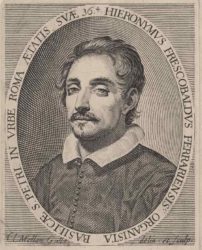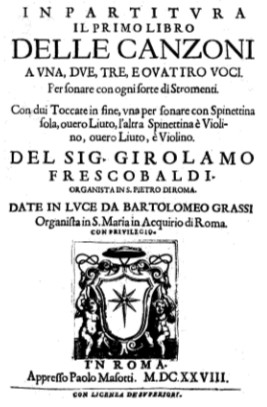16.1 Musicological interest has historically focused on the development of the sonata, above all the solo and trio sonatas. This emphasis has led to the comparative neglect and undervaluation of genres and instrumental combinations that do not apparently feed into this retrospectively defined mainstream. In fact, however, instrumental music for a variety of media in a basically conservative idiom was an important part of Italian musical production past the middle of the seventeenth century, as witness the works published by Francesco Cavalli in 1656, many of which might have been composed half a century earlier as far as their outward style is concerned. Frescobaldi defined the merit of his 1628 ensemble canzoni in partbooks—a new venture in his output—as “the variety of the inventions” (“la varietà dell’inventioni”) with which “I have regarded the convenience of various instruments” (“hebbi riguardo alla commodità di vari istromenti”).
16.2 In his Della musica dell’età nostra che non e punto inferiore, anzi è migliore di quella dell’età passata (Soleri 1903, 148-79), Pietro Della Valle described “Playing in the company of other instruments,” the role of the continuo player in Frescobaldi’s Canzoni:
This [style of playing] does not seek out so much the artful devices of counterpoint as the graces of the art; because, if the player is good, he does not need to stress so much showing off his own skill, as accommodating himself to the others (159)… (“159: Il sonare in compagnia d’altri strumenti non ricerca tanto gli artifici del contrappunto, quanto le grazie dell’arte; perchè, se il sonatore e buono, non ha da premere tanto in fare ostentazione egli solo dell’arte sua, quanto in accomodarsi con tutti gli altri. …”).
16.3 Three original editions of Frescobaldi’s Canzoni exist: Girolamo’s set of partbooks and a version in score by his student Bartolomeo Grassi, “Organista in S. Maria in Acquirio di Roma,” both published from moveable type in Rome in 1628, by G. B. Robletti and Paolo Masotti respectively; and the composer’s revised part-book version, also typeset, issued in Venice by Alessandro Vincenti, whose title page is dated 1634 and Frescobaldi’s dedicatory letter is signed at Venice on 10 January 1635.[1] Etienne Darbellay has hypothesized that the Venetian canzonas originally in the 1628 Roman editions made up the core of the first book of canzonas, and that the new and extensively revised items of the Vincenti edition represent an abandoned attempt to create a book II, an attempt perhaps also reflected in the posthumous 1645 Canzoni alla francese.
16.4 Since neither of the 1628 editions is more precisely dated, their priority is unclear. In favor of Grassi’s edition are its careful preparation and precise alignment (a rarity in partitura publications, as Grassi himself points out):
I have put this volume in score so that it might be convenient for the professionals of every sort of instrument, & that at the same time they might be able to see all the parts … they will find [the score] to be very aligned, & easy, so much the more that as they will see this work has been printed with such exquisite care in this respect, that each of the notes carries its value in the proper place, a thing not seen by me in previous scores until now … [2]
16.5 Grass’s text is more accurate than Frescobaldi’s and includes three additional works (a toccata for spinettina and violin, and a toccata and canzona for spinettina), and his concluding address “alli studios dell’opera” lacks any reference to a pre-existing edition.
16.6 Although issued by a Roman publisher, Grassi’s edition was oriented toward his native city of Lucca. Lucca was a political anomaly: in theory it was an independent republic like Venice and Genoa (its freedom decreed by Emperor Charles IV in 1369). Its form of government, established in 1556, was an oligarchy,. The religious character of Lucca was also anomalous. Although the seat of a bishopric, it had been a refuge of heretics in the sixteenth century, and in the seventeenth the city continued to refuse to admit the Inquisition and the Society of Jesus. The bishops of Lucca regularly contested papal decrees, and the city even repelled a papal representative in 1639, prompting a papal interdict the following year (although delegates from the city had been favorably received by Urban VIII’s nephew Francesco).
16.7 Grassi dedicated the Canzoni to a Lucchese nobleman, Girolamo B[u]onvisi (1607-1677, cardinal 1657), of whom he was the “deuotissimo seruitore.” Although Bonvisi was a cleric of the Camera Apostolica and a member of the Barberini circle, a twenty-one-year-old of middling ecclesiastical rank seems a somewhat unusual dedicatee. Grassi, almost defiantly “glorying in being a subject of the Most Serene Republic of Lucca,” increased the dose in the names he added to Frescobaldi’s originals. These titles commemorate 1) notable citizens or families of Lucca 2) musician friends of Grassi 3) humors (e.g. “La Superba”).
16.8 In honor of Girolamo Bonvisi, Grassi added a dedicatory canzona, “La Bonvisia,” before Frescobaldi’s “Canzona prima.” Canzona 21, “La Tegrimuccia,” refers either to Tegrimo Tegrimi, cameriere of Urban VIII, later bishop of Assisi (1630-41), or to the prelate Orazio Tegrimi, secretary of the Congregation for the Reform of the Breviary. “La Franciotta,” Canzona 23, recalls Marcantonio Franciotti (1592-1666), later an extremely controversial bishop of Lucca and the somewhat listless patron of the artist Pietro Testa. “L’Arnolfinia” Canzona 31, is named for Orazio Arnolfini, a chierico regolare of Santa Maria in Campitelli in Rome. “L’Altogradina,” Canzona 32, memorializes the jurist, letterato, and Lucchese patriot Lelio Altogradi. Other Lucchese noble families commemorated in the Canzoni include the Samminiati, Lucchesini, Nobili, Garzoni, Cittadelli, and Sardini.[3] Reflecting Grassi’s Roman milieu are Canzona 18, “la MASOTTI [sic],” dedicated to the publisher himself; “La Nicolina,” Canzona 22, perhaps in honor of Bartolomeo Niccolini, bass of the Cappella Pontificia and performer on Della Valle’s “theorbo triarmonico”; “La Capponcina,” Canzona 36, perhaps in honor of the amateur composer Gino Angelo Capponi; “La Bianchina,” Canzona 13, for the singer Giuseppe or Francesco Bianchi; “La Vittoria,” the Canzona for spinettina sola, for Loreto Vittori; and “La Rovellini,” Canzona 33, for the author of poesia per musica Cristoforo Rovelli [identifications from Darbellay 2002, I, xxi-xxix (Christine Jeanneret); Franchi 605-07.] Personal humors depicted include “l’Altera,” (“the Proud,” Canzona 6), and “l’Ambitiosa” (Canzona 8).
16.9 Frescobaldi’s 1628 part-books show haste and carelessness in their preparation, and it seems likely that he threw the collection together to provide a work to dedicate to his new prospective patron, the Grand Duke of Tuscany. However, if Frescobaldi had “infiniti altri volumi” of unpublished works, as Grassi asserted, it seems strange that he would bother to publish a collection already in print in another format. The possible priority of Girolamo’s version is strengthened by details of Grassi’s edition that suggest that he was working from Frescobaldi’s part-books. Grassi’s occasional omission of ties, for example, points to unbarred printed parts rather than to a barred manuscript score as his ultimate source.[4] Although Grassi opens his collection with an extra canzona not published by Frescobaldi himself until the 1634 volume, he still numbers a later piece “Canzona terza,” as it appears in Frescobaldi’s 1628 part-books, rather than the correct “Canzona quarta.” The placement of Grassi’s informative address “Alli studiosi dell’opera” at the end of the volume rather than immediately after the dedication also suggests that it was something of an afterthought. Darbellay, whose edition is a masterpiece of the scrutiny of typographical evidence, concludes “1) that the Grassi edition cannot be earlier than the other [Robletti] and 2) if Grassi did not depend directly on the Robletti text … he based himself on a common manuscript source, furnished by Frescobaldi to both publishers” (2002, I, xix). Perhaps the two editions served complementary purposes and Frescobaldi and his student were working in collaboration.
16.10 Frescobaldi demonstrated his “regard for the convenience of various instruments” in nine different combinations, fashionable, unfashionable, and idiosyncratic. In both editions of 1628 the canzonas are arranged according to medium with similar but not identical repertories. The canzonas combine the older tradition of the four-part ensemble canzona (CATB/bc [3], CCBB/bc [5]) with the newer solo and trio textures of Frescobaldi’s contemporaries such as Biagio Marini (Frescobaldi’s predecessor in the use of tempo indications) and Dario Castello: C/bc, CB/bc, CC/bc, CCB/bc, as well as original solutions: B/bc, BB/bc, CBB/bc. (By comparison, Johann Hieronymus Kapsberger’s first book of Sinfonie a quattro [Rome: Robletti, 1615: Franchi 2006, 1615/6], the product of his private accademia, contains fourteen works for CCBB/bc, one each for CB/bc and CC/bc, and two for C/bc.)
16.11 One legacy of the older ensemble canzona is the anomalous role of the obbligato bass throughout the Canzoni. Even where the bass is the only solo part, it generally follows the continuo line (or the continuo is a reduction of the bass line) and rarely engages in independent figuration. Thus the canzonas for canto solo, CB, and CBB are subdivisions of the same medium, as are those for CC, CCB, and CCBB. Where two basses are employed, they frequently alternate with each other over the continuo line:
Ex. 16.1. A due Bassi. Canzona decimaquarta, detta la Marina, mm. 1-11

16.12 Despite Frescobaldi’s announced concern for “the convenience of various instruments,” he rarely specified the instrumentation of the indicated voices. In the part-books the basso continuo is allotted to the organ; of the first four canzonas for canto solo and continuo, three are assigned to violin or cornett, the fourth to violin. The bass parts of the fourth canzona in four parts bear the indications “Tiorba” and “Violino,” which recalls a direction of Kapsberger in the preface of his Sinfonie: “For First, & second Bass is understood whatever instrument plays chords, as would do Lute, Chitarrone, Harpsichord, Harp, & the like. For first & second Canto, Violin, Cornett, & the like.”[5] The occasional presence of continuo figures in more than one bass part also suggests performance by more than one continuo/harmonic instrument. The indication “come stà,” “as it lies,” that heads the first four C/bc canzonas in Grassi apparently indicates that they do not require transposition for performance on the violin or cornett as specified in Robletti. (As is often the case with synoptic editions, not all the necessary information is available in any one source.)
16.13 The general formal outline of these ensemble canzonas follows the expanded framework of the keyboard canzonas in the 1627 Toccate. They begin either directly with imitative material (often the stereotypical dactyllic canzona-motif) or with a chordal introduction in duple or sometimes in chordal triple meter alla napoletana (O3/1: 1628 Canzonas XXVIII, XXXII, 1634 Canzonas 14, 23). They proceed by a series of sections contrasting in meter, tempo, and sometimes dynamics, each defined by a full or half-cadence on the tonic or a related degree. Variation techniques are the basis of thematic manipulation in these canzonas, and many of them are strict variation-canzonas in which the material of all the component sections is derived from the opening subject. The number and variety of sections are greater than those of the keyboard canzonas, and where repetitions are indicated they show less stereotyped patterns.
16.14 The ensemble canzonas display a number of triple mensurations and notations (Darbellay 2002, I, 36):
| Table 16.1 Ensemble canzona triple mensurations | ||
| Complete | Abbreviated | Patterns |
| Ø3/2 (Ø3/1) | Ø3 | three whole notes |
| O3/1 | O3 | three whole notes (also black) |
| O3/2 | O3 | two dotted wholes |
| three halves | ||
| C3/2 | C3 3 3/2 | three halves |
| 3 | 3 | three quarters (also black) |
——————————————————————————————————
16.15 These may be compared with a synopsis of the triple mensurations given by Stembridge in the prefaces to the keyboard volumes Toccate I and the Capricci (Stembridge 2009 and 2015):
| Table 16.2 Keyboard triple mensurations | |
| three whole notes | |
| O3/1 | three wholes |
| O3 | three wholes |
| O 3/2 | three wholes |
| three half notes | |
| three halves | |
| two dotted halves | |
| three quarter notes | |
| 3 | three halves |
| three quarters | |
| ¢3 | three wholes |
| C 3/2 | three quarters |
| 3 | two dotted halves |
| 3 | dotted half = half of previous C |
| 3 | three or six black quarters |
16.16 In the 1628 Canzonas the most frequently employed triple mensurations are ![]() 3/2, the related
3/2, the related ![]() 3, and O3/1, with proportional 6/4 and 12/8. In the 1634 publication O3/1 and
3, and O3/1, with proportional 6/4 and 12/8. In the 1634 publication O3/1 and ![]() 3/2 overwhelmingly predominate (some fifteen appearances each), with one appearance of 3/2 and four of black 3 (plus 6/4 and 12/8).
3/2 overwhelmingly predominate (some fifteen appearances each), with one appearance of 3/2 and four of black 3 (plus 6/4 and 12/8).
16.17 Some aspects of the Canzoni show the influence of contemporary instrumental publications. Tempo indications occur here for the first time in Frescobaldi’s works, “adagio” for a cadence or a free transitional section like the pivotal passages in the keyboard toccatas, followed by “alegro” or “allegro” (or later “presto”) to indicate a return to the typical sprightly affetto of the canzona. An adagio beginning may also be implied by a subsequent allegro marking. (However, in Canzona 6 a section in O3/1 following an allegro in C is marked “Allegro.” What this means for the concept of notation as indicating tempo remains to be determined.) Dynamic indications—forte and piano echo effects—occur frequently, as they do in Trabaci’s Secondo libro of 1615 and the 1621 sonatas of Dario Castello.
16.18 Within the boundaries of the genre, the canzonas for each of the various combinations of parts differ in detail from each other. Grassi’s second canzona (the first in Frescobaldi’s 1628 parts) for canto solo, “la Bernardina,” shows how Frescobaldi treated the solo canzona medium. The first three sections of the canzona, two imitative allegros with a central adagio half-cadence on E, make up a larger organization ending with an adagio cadence on the tonic A, thus creating a tonal contrast within a context of overall balances that is characteristic of the collection. [6] (The emphasis on a tonic and a clearly defined series of relationships around it does not force Girolamo to forgo harmonic richness and ambiguity: as in the toccatas, he can inflect scales either tonally or modally and treat any degree as the basis for a major or minor sonority.) The center of the work is formed by alternating triple allegros (![]() 3/2, 3) and duple adagios. The allegro sections of the canzona are imitative in texture, the adagios free and more or less ornamental (and probably embellished ex tempore). The imitative material of the allegros is all derived from the opening motif of a descending fourth and its tonal answer, a descending fifth, followed by a leap of a third and stepwise movement. The last section opens with an inversion of the opening descending motif now spelled chromatically (mm. 58-65) and balanced by a sequential passage that would be unusual in the keyboard canzonas (mm. 66-72). A delightful echo coda ends the canzona piano (mm. 73-86):
3/2, 3) and duple adagios. The allegro sections of the canzona are imitative in texture, the adagios free and more or less ornamental (and probably embellished ex tempore). The imitative material of the allegros is all derived from the opening motif of a descending fourth and its tonal answer, a descending fifth, followed by a leap of a third and stepwise movement. The last section opens with an inversion of the opening descending motif now spelled chromatically (mm. 58-65) and balanced by a sequential passage that would be unusual in the keyboard canzonas (mm. 66-72). A delightful echo coda ends the canzona piano (mm. 73-86):
Ex. 16.2. Canzona prima (Grassi 2, “la Bernardinia”), C/bc, complete
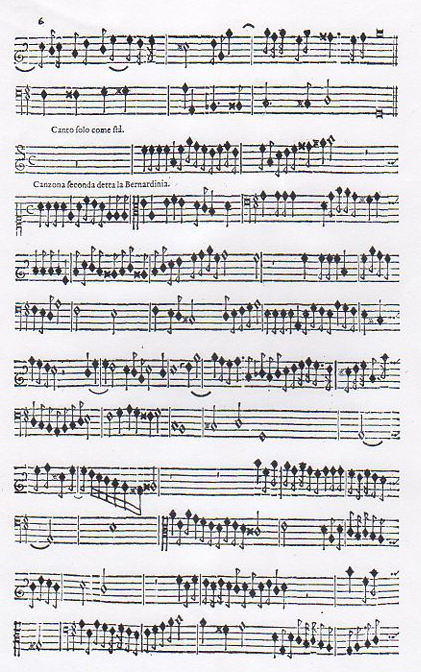
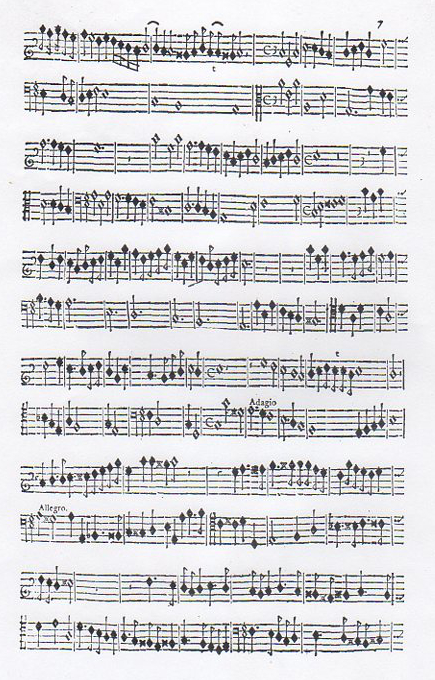
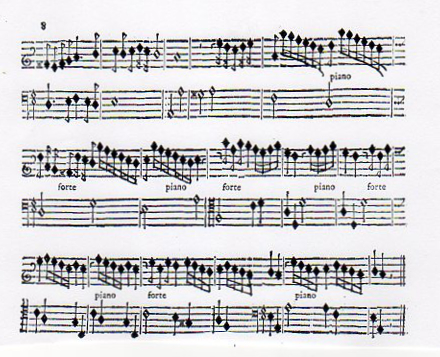
16.19 Structurally, the canzonas for CB/bc and CBB/bc follow the same general outline, but their texture is occasionally enriched by independent bass writing:
Ex. 16.3. Canzona 2a (Grassi 19, “La Capriola”), CB/bc, mm. 1-40
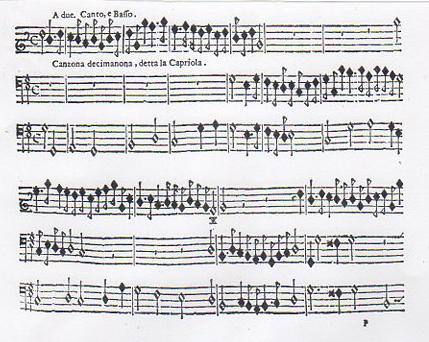
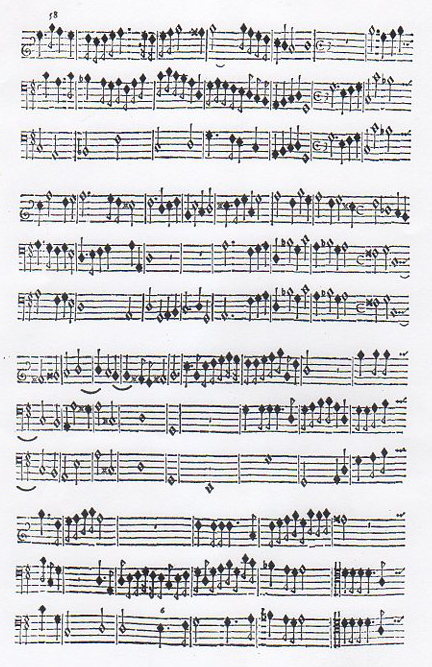
16.20 The canzonas for two canti, CC/bc, CCB/bc and CCBB/bc, whose trio-sonata texture of two dominant upper parts and continuo was well established by 1628, display the repertory of accepted devices for works featuring two treble instruments—alternation of subject and countersubject between the two solo parts, suspensions, echo effects, and virtuosic cadential passaggi—within the structural framework of the variation canzona. In the CCBB/bc canzonas the two basses alternate in doubling the continuo line and presenting independent material.
16.21 Frescobaldi was the first composer to publish canzonas for solo bass and continuo, although the combination had a distant ancestor in Diego Ortiz’s Tratado de glosas of 1553, and he produced more than half of the surviving canzonas for combinations involving two basses (BB/bc, CBB/bc).
16.22 Perhaps owing to the experimental nature of the medium, the canzonas for bass solo rely less on variation techniques than on the juxtaposition of a number of contrasting sections. These include extended free sections, interspersed passages in triple and compound meters, and soloistic improvisatory passaggi:
Ex. 16.4. Canzona 4a (Grassi 7, “la Superba”), B/bc, mm. 54-89

16.23 In the canzonas for two basses and continuo the outlines of the bass and continuo are similar, and the alternation of the two solos again often reduces the texture to a single line. Here the interest centers on Frescobaldi’s manipulation of the relation between the two soloists, the length and speed of their alternations. (In G.F. Anerio’s instrumental “Simphonia” for his Dialogo Figliol Prodigo [Teatra armonico, 1619], for example, the theorbo and lute bass parts alternate, while the organ continuo provides a simplified summary.) In the fourth canzona for two basses, for example, after the first imitative section the second bass presents a long, almost recitative-like phrase, answered by the first. As they dialogue the phrases alternate more rapidly, and finally the two parts intertwine at the cadence. This type of dialogue recurs twice again in the canzona, finally emerging to dominate the last section, an extended passage in consistent figuration:
Ex. 16.5. Canzona 4a, Grassi 17, “la Diodata,” BB/bc, mm. 26-43, 100-24
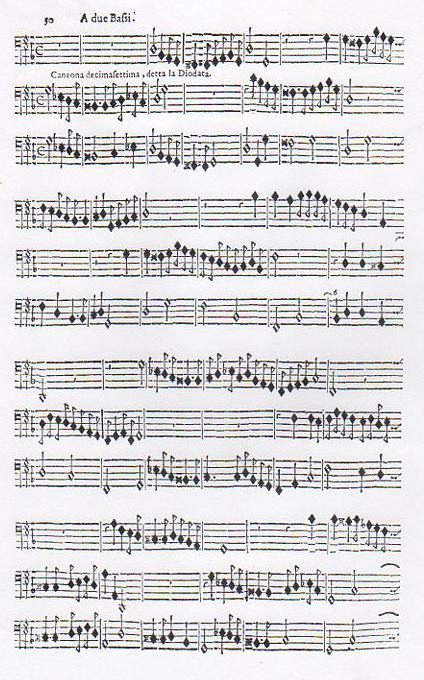


16.24 In these works the coalescence of the various bass lines is most emphasized; this may have been mitigated in performance by a continuo realization which took an active part in the development of motivic material. (The fact that some canzonas begin with the continuo doubling the C in an upper register, after which it enters in the bass, suggests that the opening line may have been continued in the accompaniment as an improvised polyphonic counterpoint.)
16.25 Perhaps Della Valle gives a hint of this when he writes:
Those who sing and play well in ensembles have to give the tempo one to another, and they have to play rather with charming imitations than with too subtle contrapuntal artifices (Solerti 1903, 159: “Quei che cantano e sonano bene, in compagnia si hanno da dar temp l’uno all’altro, e piuttosto che con artifizi troppo sottili di contrappunti, hanno de scherzar con leggiadria d’imitazioni.”)
16.26 The texts of Grassi’s and Frescobaldi’s editions of 1628 generally coincide except for details of the canzonas in four parts (CCBB/bc, CATB/bc), where divergences are wider. To begin with, Grassi includes eight four-part canzonas, while Frescobaldi’s own edition contains only six, omitting Grassi’s numbers 34 and 37. (Number 34 was reinstated in the 1634 collection.) In the works common to the two 1628 editions there are notable textual differences. In the second canzona, for example, Grassi’s version consists of an opening section, repeated, followed by sections two to five, repeated as a unit. Frescobaldi’s version adds new sections between one and two and between three and four and suppresses the repeat. Grassi’s number 34, when it turns up in the 1634 volume, is identical with Frescobaldi’s version only for the first thirty-two measures. (cleffing: CATB, Darbellay Part 1: xxxv: chiavette; xxxvi: naturali; xxvii: chiavette. Part II: 21: chiavette; 22-26: naturali).
16.27 Perhaps because they are closest in medium to the keyboard canzona, a genre in which Frescobaldi had worked for over a decade, his four-part CATB canzonas as a group show a firm touch in combining striking effects for the upper parts with significant participation in the musical fabric for all the voices. The texture of these works is imitative, and they are more tightly contrapuntal than the other canzonas, reflecting the archaizing tendency of the four-part medium. All of them are variation-canzonas, and in Grassi’s version none has more than one section in triple meter.
16.28 The Canzona 36 à 4, “La Capponcina,” of Grassi’s collection represents an apparently unique connection in Frescobaldi’s output between an ensemble canzona and a keyboard counterpart, since its opening thirty-three measures reproduce the beginning of the Canzon terza from the 1615 Recercari et canzoni. A comparison of the two works reveals Frescobaldi’s development in the intervening thirteen years. The 1615 canzona is a strict variation canzona, laid out in regular alternation of duple and triple meter sections, in all of which the subject is clearly recognizable:
Ex. 16.6. Canzona terza, Recercari, 1615, mm. 1-37


16.29 Even though some of these sections close on D rather than on the tonic G, the latter is immediately reestablished. The revised canzona contains only three sections, the second in triple meter and cadencing on B-flat, reached from the quoted material by a transition which effects a real modulation. The material is more subtly derived from the initial motif, internal divisions are overlapped, and a short hocketing coda forms an idiomatic close:
Ex. 16.7. Canzona 6a, Grassi 36, “La Capponcina,” CATB/bc
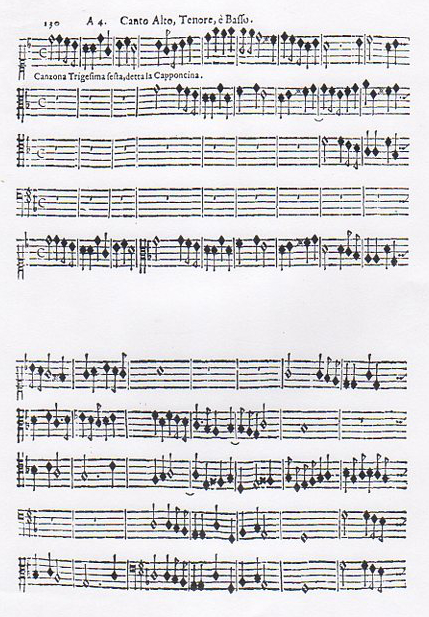

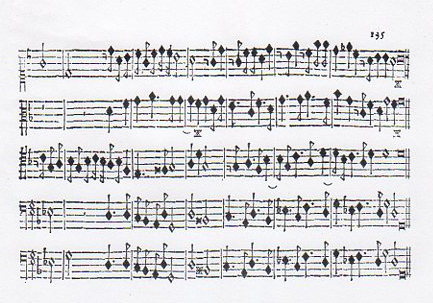
16.30 The three works that Grassi added to his edition of the Canzoni are mostly of paramusical interest. They all specify the spinettina (or lute as an alternative)—perhaps an instrument at higher pitch, quint or four-foot, or a small gut-strung harpsichord. Agazzari 1607 includes the spinetto among ornamental rather than fundamental instruments, and Frescobaldi treats it as a melody instrument in both hands above a basso continuo.[7] These works represent Frescobaldi’s first tentative experiments in the juxtaposition of free and contrapuntal genres which he later pursued in the Fiori musicali. The toccata for spinettina and violin is a canzona preceded by a rhapsodic section that functions like the introductory toccata of the spinettina pieces.
16.31 Although little is known of Frescobaldi’s musical activities in Florence between 1628 and 1634, he was clearly impelled to a drastic revision of the Canzoni. Étienne Darbellay, in the preface to his edition of the canzonas, devotes considerable attention to Frescobaldi’s payment records for Cardinal Francesco Barberini and payment and attendance records for the Cappella Giulia in order to discover a time when the composer could have been in Venice to sign the dedication, dated 10 January 1635. He concludes that the only possible dates are March-May and July-August of 1635. The question is further complicated by whether the date of January 1635 is more veneto, where the year begins on March 1, in which case it would be our 1636, or more universale. Arnaldo Morelli notes that the works of Roman authors published in Venice in January and February were nonetheless dated in modern style (Darbellay II, ix). However, Darbellay overlooks the fact that the date may be undependable in any case: for example, Frescobaldi dated the dedication of the Fantasie from Ferrara, 8 November 1608, but by that date he had been in Rome for over a week.
16.32 A comparison of the 1634 edition with those of 1628 shows far-reaching alterations in several categories (see Table 16.5). The relations between the 1628 and 1634 collections range from transfer, essentially unaltered, through more or less extensive revision, to suppression of previous canzonas in favor of new ones (see Tables 16.3, 16.4).
| Table 16.3: Comparison of the 1634 and 1628 canzona repertories: Harper 1975, 106 | ||||
| Instrumentation | 1634 | 1628 (parts) | 1628 (score) | Total |
| C/bc | 4 | 4 | 4 | 5 |
| B/bc | 3 | 4 | 4 | 4 (+3r) |
| CC/bc | 4 | 5 | 5 | 5 (+3r) |
| BB/bc | 4 | 4 | 4 | 4 (+4r) |
| CB/bc | 6 | 6 | 6 | 6 |
| CBB/bc | 4 | 3 | 3 | 5 (+2r) |
| CCB/bc | 5 | 3 | 3 | 5 (+1r) |
| CCBB/bc | 4 | 4 | 5 | 6 (+2r) |
| CATB/bc | 6 | 2 | 3 | 8 (+1r) |
Note: r = revision
16.33 Darbellay hypothesizes that Frescobaldi had originally planned a second volume of canzoni, traces of which survive in the discarding of all of the 1628 canzonas for basso solo and all but one of the canzonas for four instruments.
| Table 16.4: The 1634 canzonas and the 1628 prints: Harper 1975, 107 | |||||
| Instrumentation | Transferred | Revised | New | Total | Discarded |
| C/bc | 4 | — | — | 4 | (1) |
| B/bc | — | 3 | — | 3 | (1) |
| CC/bc | 1 | 3 | — | 4 | (1) |
| BB/bc | — | 4 | — | 4 | — |
| CB/bc | 6 | — | — | 6 | — |
| CBB/bc | — | 2 | 2 | 4 | (1) |
| CCB/bc | 2 | 1 | 2 | 5 | — |
| CCBB/bc | 1 | 2 | 1 | 4 | (2) |
| CATB/bc | — | 1 | 5 | 6 | (2) |
| Total | 14 | 16 | 10 | 40 | (8) |
16.34 The first volume of Darbellay’s edition of the canzonas presents the canzonas of 1628 plus those that remained substantially unchanged in 1634, with later variants noted in ossia lines or in the critical notes. Volume II presents the 1628 canzonas that were substantially modified in 1634 and the new ones added, which Darbellay considers the survivors of a projected Secondo libro.
| Table 16.5: The 1634 canzonas and the 1628 prints: Darbellay 2002, II, xi | |||||
| Vincenti # | Instrumentation | New | Important variants | = Grassi | Discarded |
| 3 | B/bc | 3 | 4 | ||
| 10 | à 4 | 7 | 2 | 1 (n. 30) | 5 |
| 4 | BBC/bc | 2 | 2 | 1 | |
| 5 | CCB/bc | 2 | 1 | 2 (nn. 28, 29) | |
| 4 | BB/bc | 4 | |||
| 4 | CC/bc | 3 | 1 (n. 11) | 1 | |
| 4 | C/bc | 4 (nn. 1-4) | |||
| 6 | CB/bc | 6 (nn. 18-23) | |||
| 40 | 14 | 12 | 14 | 11 | |
16.35 A comparison of a 1628 canzona with its later reworking shows how complex these revisions can be. The last of the bass canzonas (Canzona 8, “detta l’Ambitiosa” in Grassi, Canzona terza basso solo in the 1634 parts) is longer by three sections in its second version, and much of what survives from its earlier state is considerably altered. (Indeed, Darbellay lists Vincenti’s version as “new” and the 1628 version as “discarded.”) Frescobaldi replaced the original adagio introduction by a new one of the same length but changed only the final chord of the ensuing allegro. The original triple section that followed and its replacement (O3/1) are both based on the allegro material. The rhapsodic passaggi of the first version were supplanted by a straightforward adagio, followed by an interpolated 6/4 allegro and an adagio, and concluded by the last six measures of the allegro that they replace. The next adagio of the original is expanded from six breves to ten, and instead of the passage-work which concludes the first version, there are two new sections, an allegro and a tripla (black 3):
Ex. 16.8. a) Grassi, Canzona 8, “detta l’Ambitiosa,” B/bc, mm. 1-40 b) Canzona terza basso solo, 1634, mm. 1-34
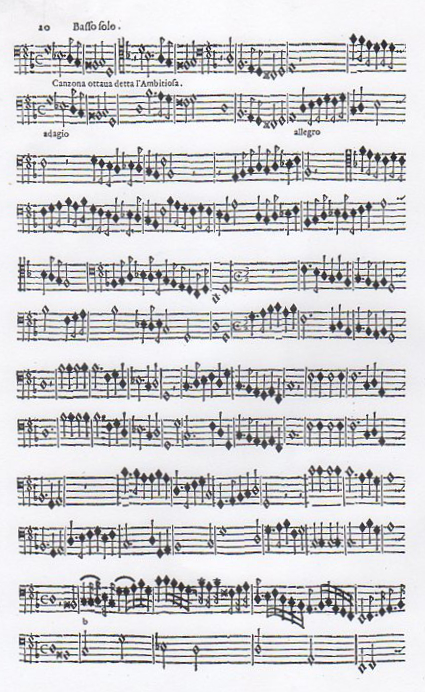

16.36 In general, these revised solo bass canzonas contain much less of the expressive instrumental declamation evident in the earlier versions. The number of sections per canzona tends to increase, especially the adagio passages. The same is true of the revisions in the canzonas for two basses, although some of the rewriting, as in the tightened opening section of Grassi’s Canzona 16 a due bassi, “detta la Marina” (Canzona prima a due bassi in 1634), has a clearer rationale.
16.37 The most obvious alterations in the canzonas for two canti (the canzonas for CCBB/bc are a subset of the CCB/bc canzonas) consist in the elemination of the dramatic forte-piano contrasts of the first versions. In the canzonas for canto and two basses, on the other hand, the alternations between homophony and counterpoint in the revised first canzona, the chromatic adagio of the new third, and the processional opening and echo effects of the new fourth all increase the sensuous effect of the works.
16.38 Of the canzonas for four instruments, Robletti contained three of those scored for CCBB and Grassi five. Vincenti presented four: three new ones, two with important variants [Darbellay 2002 I, xxx]. CCBB: Grassi 30, “La Citadellia”; Robletti; Vincenti with variants; Grassi 31, ”L’Arnolfinia”; Robletti; not in Vincenti; Grassi 32, “L’Altogradina”; Robletti; not in Vincenti; Grassi 33, “La Rovellina”; Robletti; Vincenti with variants (II: Canzona II); Grassi 34 “La Sandoninia”, only in Robletti. Vol. II: Canzon 1a: new 2a: new 3a: new.
16.39 The CATB canzonas played a small role in the 1628 prints (three in Grassi, two in Robletti). In preparing the 1634 volume, perhaps with Cardinal Francesco Barberini’s viol consort in mind, Frescobaldi added five new works in this medium and completely revised the one he retained from the earlier collection. This group of six four-part canzonas, all CATB/bc, opens with two works built on bass patterns, the only works of this type in the three versions of the Canzoni. The basses chosen are the subjects of Frescobaldi’s most important harpsichord variation-sets in the 1615 Toccate, the Romanesca and the Ruggiero. Here they are treated as variation-canzonas: the preexisting material is stated in the bass, and each statement forms one section of the canzona. The basso continuo presents the original version of the bass line, and the instrumental bass participates in the web of short imitative patterns woven by the upper parts while maintaining the outlines of the original pattern under the decoration. The finale of the Romanesca is almost a gigue:
Ex. 16.9. Romanesca, CATB/bc, mm. 69-86

16.40 Unlike the keyboard capriccio on the Ruggiero, in the Ruggiero canzona the material in the upper parts is not derived from the bass, with one striking exception. The Ruggiero canzona consists of five sections (C, O3/1, C, 3, C), each corresponding with a statement of the bass until the end of the fourth section, when the seemingly inevitable cadence on G is wrenched around to C (m. 58) and the alto plays, as a kind of cantus firmus, the last phrase of the Ruggiero, now transposed to C. This dislocation is finally remedied by the bass, which finishes the canzona by completing the original interrupted cadence:
Ex. 16.10. Canzona prima sopra Rugier, CATB/bc, mm. 50-71

16.41 The remaining four canzonas are among the most successful works in the collection. Like the two on bass patterns, they are tightly woven contrapuntal works that develop one or a pair of motives imitatively in a series of closed sections. While these sections may contrast greatly in character, much of the thematic material is consistent, notably a penchant on the part of the composer for quartal themes. Some, like Canzona III and Canzona VI, are variation-canzonas. In others, thematic opposition is created as in Canzona IV, where Frescobaldi introduces a narrow chromatic motif in the last section as a foil to the open fourths and fifths of the first two sections. Canzonas III, V, and VI all contain passages of extensive syncopation and rich dissonance. Unlike earlier canzonas, no sections are repeated, and no tempo alterations are indicated (although Canzonas IV, mm. 36-38, and V, mm. 55-64, contain sections that suggest an adagio marking). Canzonas III and IV open with chordal passages rather than the usual imitation, and all except the last canzona contain passages in which a full chordal texture is presented as a contrast to the prevailing imitative one.
Ex. 16.11 Canzona terza, CATB/bc, mm. 1-34
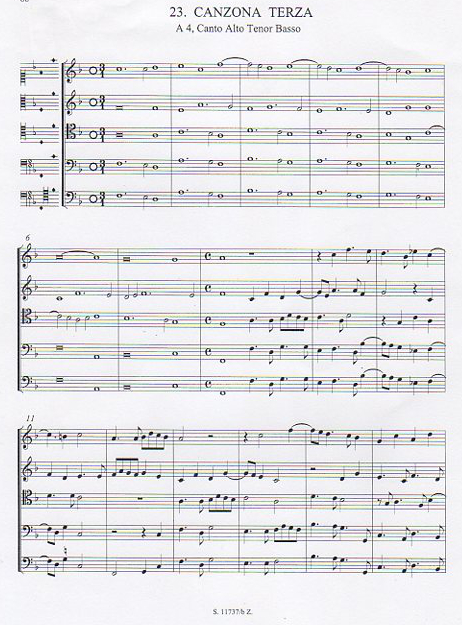
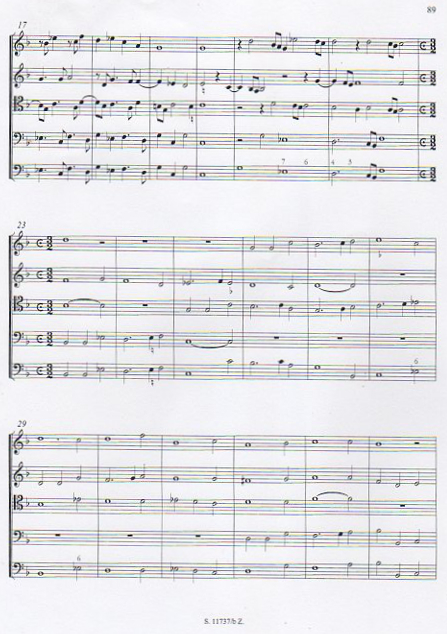
16.42 In general, these last four-part canzonas and many of the revisions of the other canzonas show Frescobaldi moving away from the more obvious effects of contemporary instrumental music to a renewed concern with concision without shortness of breath and extension without prolixity evident in his last works.
16.43 Both numerically and in the sheer effort that went into producing the three editions of the Canzoni they occupy a major place in Frescobaldi’s output. No other genre engaged his attention from the very beginning of his career until, in a sense, beyond its end. And yet the Canzoni are still the least-known part of his ouevre. With greater familiarity we may come to recognize that these works, with their extraordinary variety of instrumentation and musical material, form a worthy counterpoise to Frescobaldi’s corpus of keyboard compositions.
FOOTNOTES

